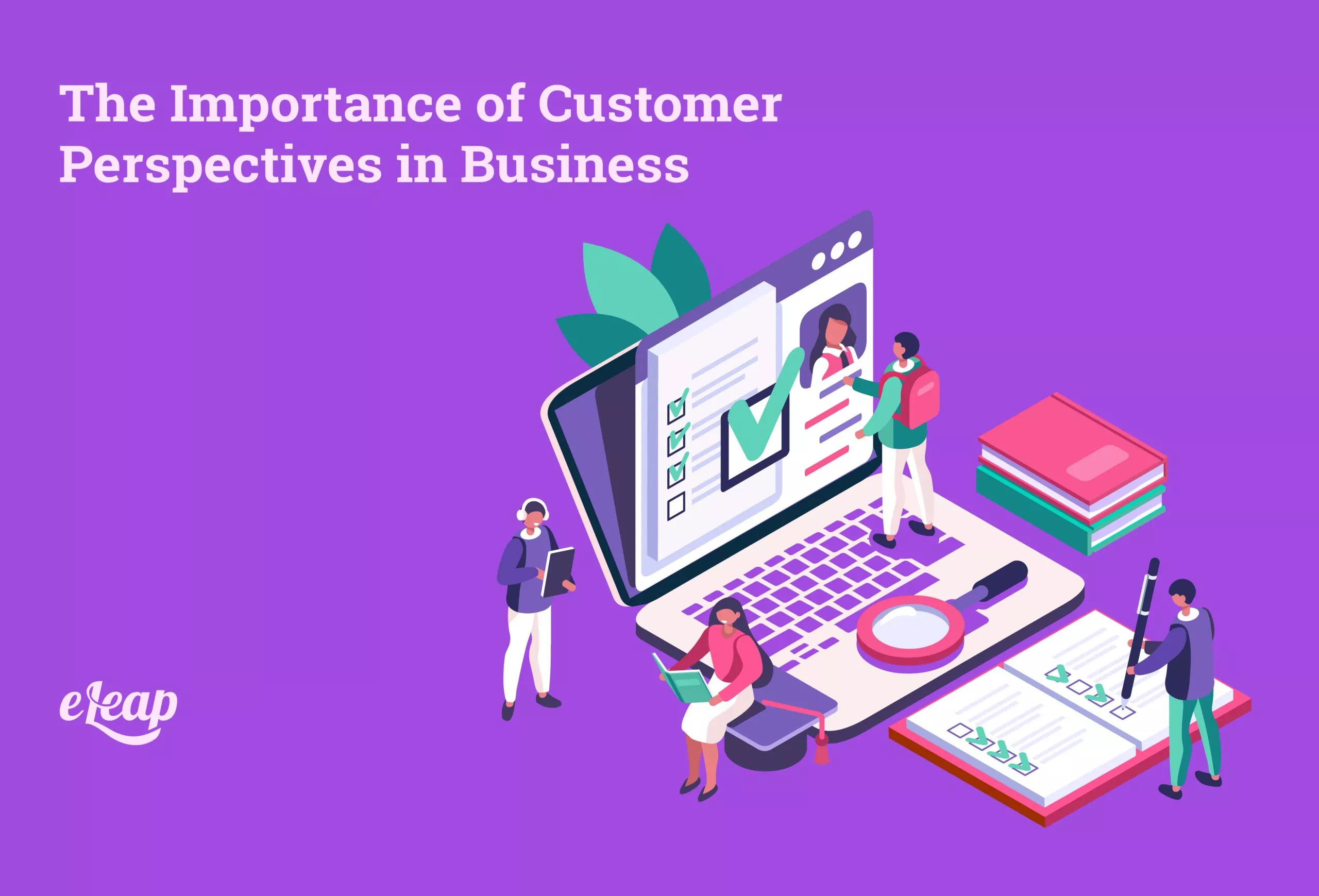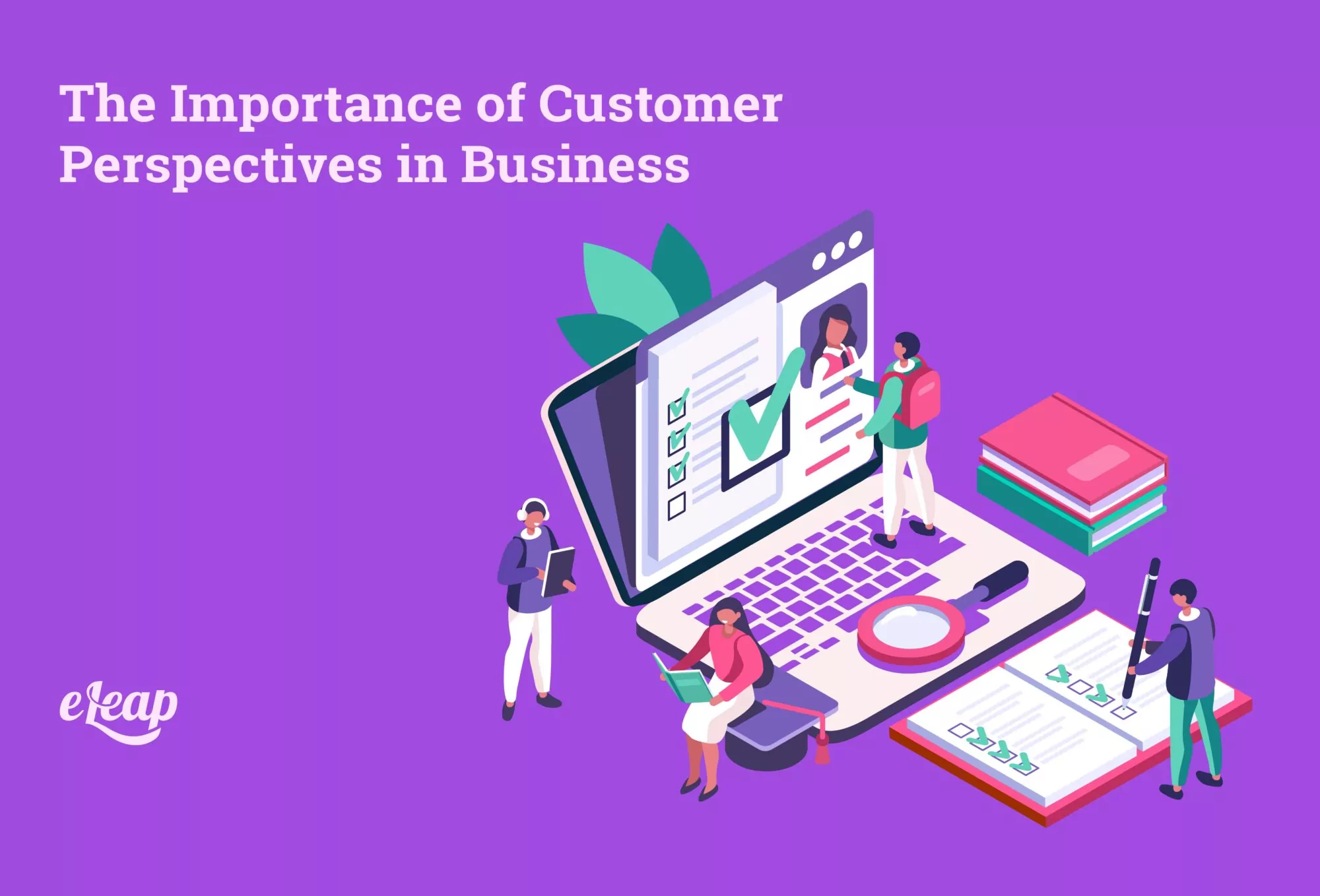The Importance of Customer Perspectives in Business

Understanding your customers’ perspective is no longer just a nice-to-have; it’s essential for business success. Customer perspective refers to how customers perceive and experience your product, service, or brand. Businesses can adapt, grow, and build lasting customer relationships by analyzing and responding to these insights. This article explains why customer perspective is critical for business success, how it influences growth, and how businesses can integrate it into their strategies to maintain a competitive edge. See how eLeaP®’s Performance Management Platform helps you apply these insights to drive better results.
Why Customer Perspective is the Cornerstone of Business Success
Understanding your customers is key to maintaining relevance in today’s rapidly evolving market. This process is about knowing what your customers want and understanding how they think, feel, and react at every stage of their journey with your brand.
A customer’s perspective encompasses their entire experience with a business—from the moment they first discover your brand to their interactions with customer service and overall satisfaction with the product or service. Companies can tailor their offerings and operations to meet customer needs more effectively when they understand this perspective. This deeper insight is vital to creating a loyal customer base and achieving long-term business growth.
Moreover, as customers become more empowered through access to vast information, businesses that fail to consider their perspectives risk falling behind. Brands prioritizing customer feedback, emotions, and needs are more likely to attract and retain loyal customers. A company that can create an experience that resonates with customers will stand out in a crowded marketplace.
Defining Customer Perspective: The Foundation of Customer-Centric Business Strategies
At its core, customer perspective is how customers perceive and evaluate their experience with a business. It’s about their expectations, emotions, and perceptions during their interactions with a brand. It’s not just about the product or service but the complete experience, which can range from browsing a website to resolving an issue with customer support.
When businesses understand customer perspectives, they can tailor their marketing strategies, customer support, and product offerings in ways that resonate deeply with their audience. This understanding should inform every decision, from product development to sales strategies.
Customer Perspective vs. Customer Service: What’s the Difference?
Although customer service plays a crucial role in shaping a customer’s experience, it’s only one part of the broader concept of customer perspective. Customer service focuses primarily on the interaction between the customer and the company when there is an issue or a need for assistance. In contrast, the customer perspective is a more comprehensive view that includes both service and the emotional journey a customer goes through when interacting with your business.
A customer service team might resolve a problem effectively. However, if the customer doesn’t feel valued or the product doesn’t meet their expectations, the overall experience still leaves room for improvement. Customer perspective identifies and addresses the broader emotional and experiential factors that shape customer opinions.
The Emotional and Rational Factors Behind Customer Perspectives

Both emotional and rational factors shape customer perspectives. On the sensible side, customers evaluate the practical elements of a product or service, such as its quality, price, and functionality. Emotional factors, however, are just as important—they include how customers feel about the brand, how valued they feel, and how well their expectations are met.
These emotions play a critical role in customer decision-making. When customers feel heard and understood, they are more likely to return and recommend your business to others. Understanding these emotional triggers can help companies design better customer experiences that are aligned with what customers genuinely care about.
The Impact of Customer Perspective on Business Growth
How Customer Perspective Fuels Business Growth and Competitive Edge
The relationship between customer perspective and business growth is undeniable. When businesses listen to and act upon customer feedback, they can make smarter decisions that lead to higher customer satisfaction and retention. A company prioritizing customer needs is likelier to foster brand loyalty, which is often more valuable than acquiring new customers. Loyal customers tend to spend more and are likelier to promote your business to others.
In addition, businesses that focus on understanding customer perspectives can build a strong reputation. A positive reputation leads to repeat business and word-of-mouth marketing, which can significantly boost growth. More importantly, businesses that proactively respond to customer needs can differentiate themselves from competitors.
Strengthening Customer Trust and Loyalty Through Deep Customer Understanding
Trust is a cornerstone of customer loyalty, and understanding your customers’ perspectives builds that trust. Customers feel valued when a business anticipates needs and addresses pain points before escalating. This sense of being understood is key to nurturing long-term relationships.
Businesses that consistently deliver on their promises are seen as more trustworthy, encouraging customers to return and recommend the company to others. This stage is where customer feedback becomes invaluable. By gathering data and seeking feedback, businesses can continuously improve and fine-tune their offerings, creating a cycle of improvement and trust-building.
Turning Customer Insights Into Action: Innovations That Enhance Products and Services
Customer perspective doesn’t just help businesses avoid mistakes—it drives innovation. Insights from customer feedback can lead to new product features, updated services, or even entirely new business models. For example, businesses can use feedback to enhance user interfaces, streamline customer support processes, or introduce new offerings that better meet customer demands.
Companies like eLeaP understand the value of customer insights. They use feedback to continuously improve their learning management systems and adapt to users’ evolving needs. By implementing customer-driven changes, companies can ensure their products remain relevant and competitive.
Building a Customer-Centric Culture: From Insight to Action
Creating a Culture That Puts Customer Perspective at the Core
A customer-centric culture starts at the top. Leadership must set the tone by valuing customer insights and integrating them into decision-making. This culture must permeate every department, from marketing to product development to customer service.
A business that listens to and acts on customer feedback shows that it values its customers, making it more likely that employees will follow suit. Training employees to prioritize customer perspectives in their daily interactions ensures that the company operates with the customer in mind. This unified approach results in a seamless customer experience that can drive customer loyalty.
Encouraging Continuous Feedback Loops: How to Keep Your Business in Tune with Customers
Feedback is most useful when it’s continuous. Establishing regular touchpoints with customers—such as surveys, reviews, or direct outreach—ensures businesses can stay in tune with shifting needs. It’s essential not only to collect feedback but also to act upon it quickly. Customers appreciate when businesses make changes based on their input, increasing their sense of loyalty and satisfaction.
Integrating Customer Feedback into Company-Wide Operations for Better Efficiency
Customer feedback should be integrated into all aspects of the business, from marketing strategies to product development. For instance, data collected from customer interactions can provide valuable insights into market trends and consumer preferences. A system that allows for the smooth flow of this information can help companies make informed, data-driven decisions that improve customer experience and operational efficiency.
Leveraging Customer Perspective to Enhance Customer Experience
Transforming Customer Experience with a Strong Understanding of Customer Perspective
Customer experience is shaped by how a business delivers promises and meets customer expectations. With a deep understanding of customer perspective, companies can design experiences that resonate with their audience on a personal level. This process means offering personalized recommendations, anticipating customer needs, and proactively addressing potential issues.
When businesses focus on customer perspective, they don’t just sell a product or service; they create an experience tailored to each individual. This personalized touch can significantly impact customer satisfaction, showing that the company genuinely cares about its customers.
Personalization at Scale: Tailoring Experiences for Different Customer Segments
Personalization isn’t just about addressing customers by name; it’s about understanding different customer segments’ unique needs and preferences. By segmenting customers based on their behaviors, demographics, or buying patterns, businesses can provide tailored recommendations and experiences that make each customer feel special.
Companies like eLeaP excel at offering personalized experiences, especially in areas like eLearning, where users’ learning preferences and performance data help tailor educational content to individual needs. This level of personalization increases engagement and satisfaction, fostering customer loyalty.
Proactive Problem Solving: Identifying and Addressing Customer Pain Points
Identifying pain points in the customer journey is essential for improving the customer experience. Businesses can make targeted improvements that reduce customer frustration by understanding where customers encounter friction—whether during the purchasing process, navigating a website, or dealing with customer service.
Proactively solving these issues demonstrates a commitment to making the customer’s experience as smooth and enjoyable as possible, ultimately leading to higher satisfaction and loyalty.
Customer Perspective as a Strategic Tool for Innovation
Leveraging Customer Perspective for Business Innovation and Market Differentiation
Businesses that integrate customer perspective into their strategies are better positioned to innovate. Customer feedback often highlights gaps in the market, unmet needs, or areas where the competition is falling short. By listening to customers and responding to these insights, businesses can create new products, features, or services that stand out in the market.
Innovation driven by customer perspective doesn’t just keep businesses competitive; it helps them lead in their industry. By constantly adapting to customer needs, businesses remain relevant and continuously enhance their offerings.
Practical Steps to Integrate Customer Perspective into Your Business
Implementing Customer-Centric Strategies for Immediate Business Impact
To truly leverage the customer perspective, businesses need to take deliberate actions. Start by collecting customer data through surveys, reviews, and direct feedback. Use this information to guide your decision-making and refine your products and services.
For example, eLeaP has consistently refined its platform based on user feedback, ensuring its offerings align with customer expectations. This customer-driven approach has helped the company build a strong brand reputation and loyal customer base.
Data Analysis and Application: How to Translate Customer Insights into Tangible Actions
Once you have collected customer insights, the next step is analyzing them for actionable trends. Look for common patterns in feedback and use this data to inform your business decisions. For example, if customers frequently mention a feature they wish your product had, that’s a clear signal to prioritize it in your next update.
Conclusion
Businesses prioritizing customer perspective in their strategies will thrive in the coming years. As customers demand more personalized experiences, those who respond to these needs will enjoy sustained growth and loyalty. By truly understanding and acting upon customer insights, businesses will improve customer experience, innovate, differentiate themselves, and set the stage for long-term success.
Embrace the customer perspective, and your business will reap customer loyalty, satisfaction, and growth rewards.